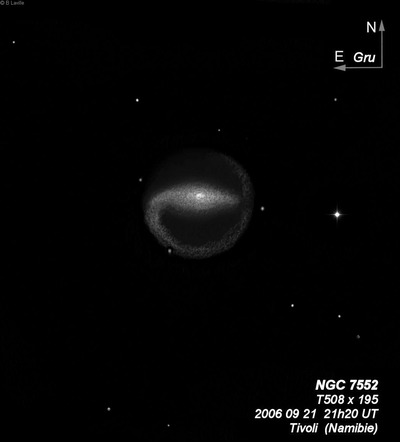
James Dunlop discovered NGC 7552 = D 475 = h3977 on 7 Jul 1826 and claimed 4 observations. He described the first member of the Grus Quartet as "a small faint nebula, rather elongated in the parallel of the equator, about 30" broad, and 40" long; there is a pretty bright point situated near the centre of the nebula: a small star precedes it."
John Herschel made a single observation on 2 Sep 1836, logging "B, S, mE, nearly in parallel; vsbM to a star 13m." Herschel credited Dunlop with the discovery. Lewis Swift found the galaxy again on 22 Oct 1897 and reported Sw. XI-226 (later IC 5294) as "pB; pS; R; 8m * p[receding] same parallel." His RA was just 9 seconds too small and his description of the brighter star clinches the equivalence.
Based on a Helwan plate taken in 1919-20, NGC 7552 was described as "vB sharp stellar nucleus; irregular Phi-type spiral; the cross-arm [central bar] is in p.a. 90° and is moderately bright at each end rather than near the middle, where a curious faint circle occurs of diameter 50"; the outer circle [ring] of the Phi is extremely faint except the southeast side."
300/350mm - 13.1" (11/5/83): fairly faint, small, elongated E-W, small bright nucleus. A mag 10 star lies 4.4' W and a mag 11 star is off the south side. The Grus trio consisting of NGC 7582, NGC 7590 and NGC 7599 are roughly 35' NE with the entire group called the Grus Quartet.
600/800mm - 30" (10/21/17 - OzSky): at 264x; very bright, very large, elongated 5:2 E-W, ~2.3'x0.9'. A brighter bar extends E-W along the major axis. The center is punctuated by a sharp, extremely bright stellar nucleus! A spiral arm was clearly visible attached at the east end of the major axis (bar). The beginning of the arm rotated counterclockwise towards the south but it shortly dimmed out after a distance ~0.6'. The main part of the galaxy is embedded in an extremely low surface brightness halo, ~3' in diameter. A mag 13.5 star is off the west end [2.2' from center] and a mag 12 star is at the edge of the outer halo [1.8' S of center]. NGC 7583, the first in the Grus Trio with 7590 and 7599, lies 28' ENE.
Notes by Steve Gottlieb